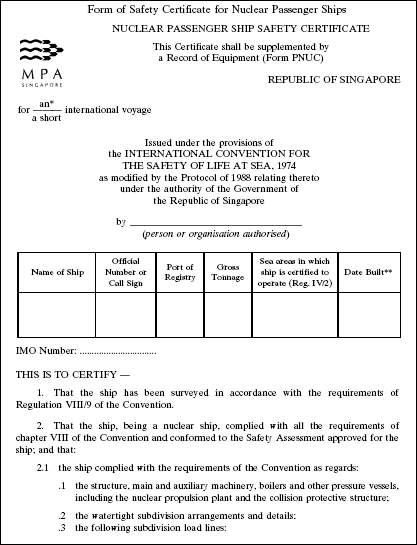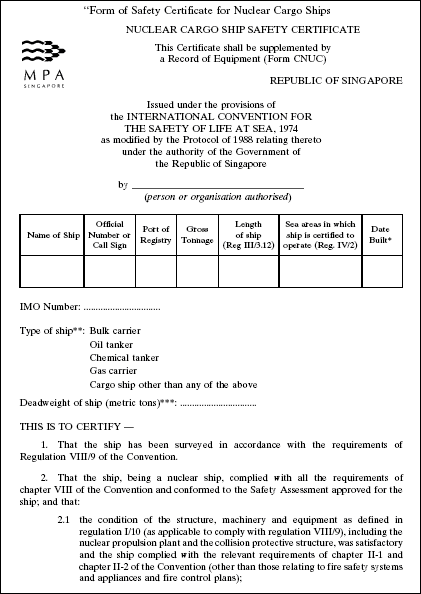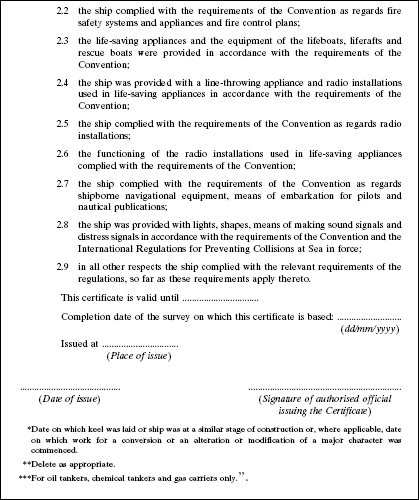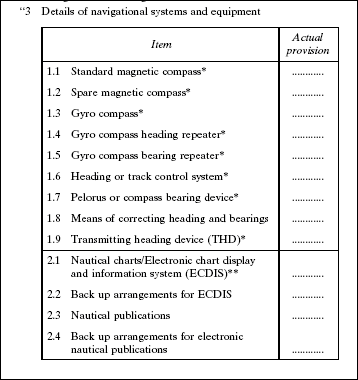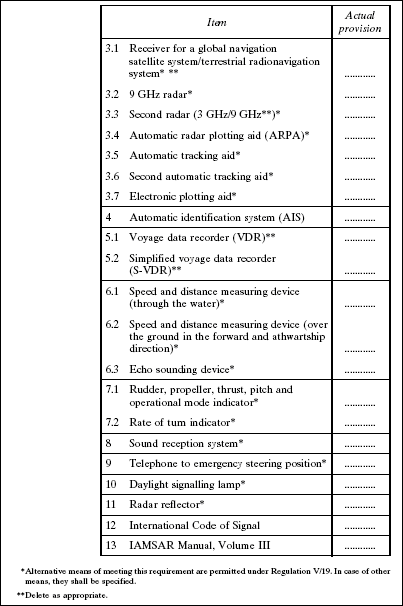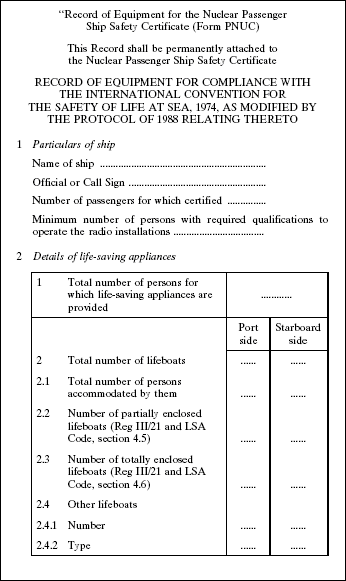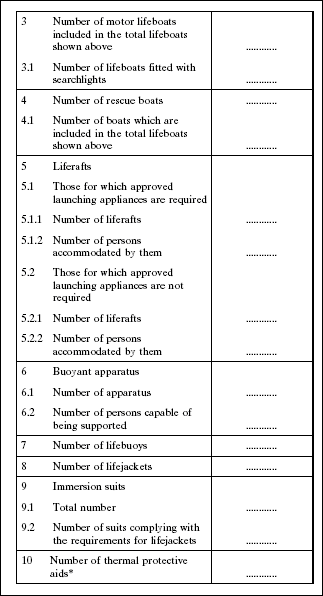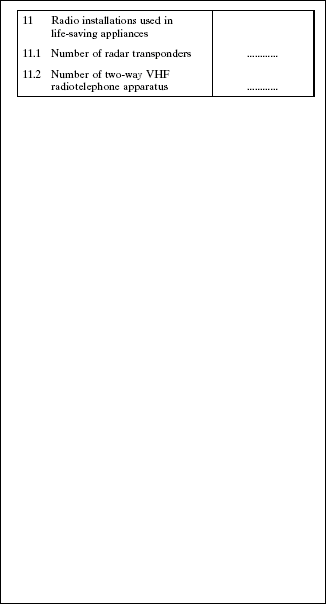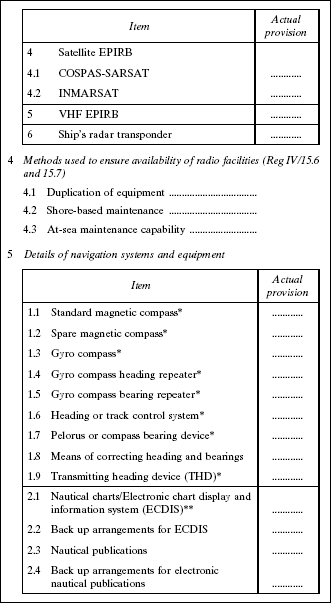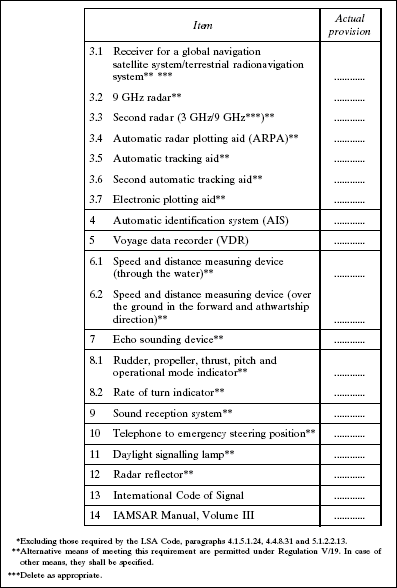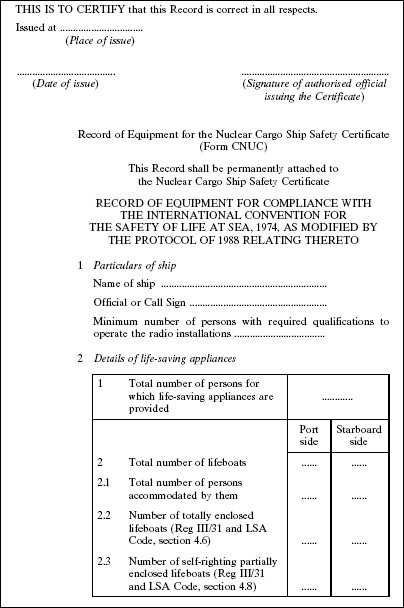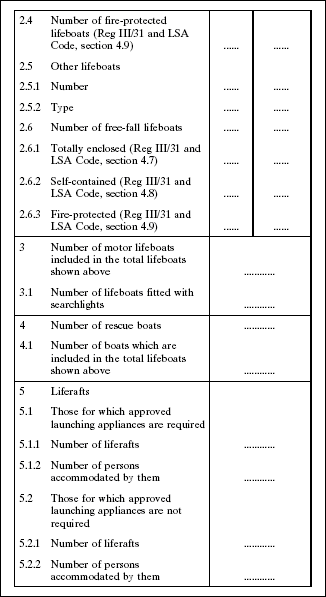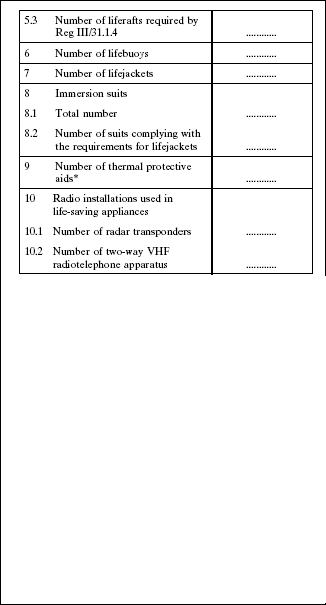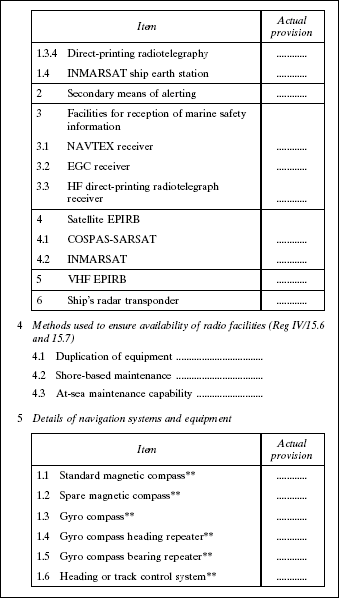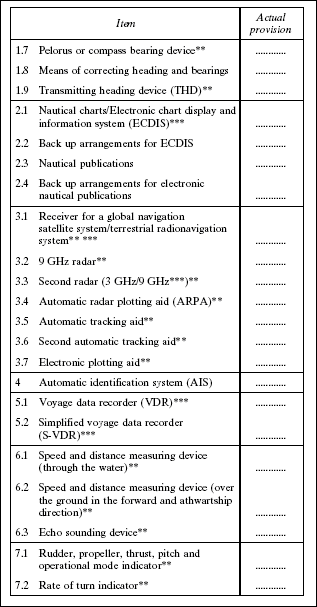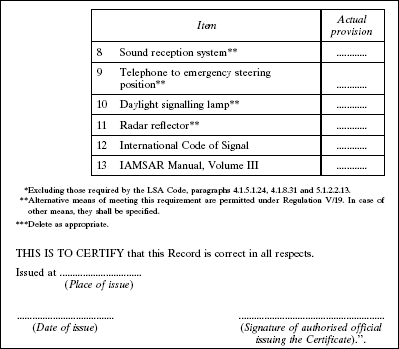19. Chapter XII of the principal Regulations is deleted and the following Chapter substituted therefor:| “Chapter XII — Additional Safety Measures for Bulk Carriers |
|
| For the purpose of this Chapter — |
| (a) | “Bulk carrier” means a ship which is intended primarily to carry dry cargo in bulk, including such types as ore carriers and combination carriers6.6 Reference is made to:| (1) | For ships constructed before 1st July 2006, resolution 6, Interpretation of the definition of “bulk carrier”, as given in chapter IX of SOLAS 1974, as amended in 1994, adopted by the 1997 SOLAS Conference. | | (2) | The Interpretation of the provisions of SOLAS chapter XII on Additional safety measures for bulk carriers, adopted by the Maritime Safety Committee of the Organization by resolution MSC.79 (70). | | (3) | The application provisions of Annex 1 to the Interpretation of the provisions of SOLAS chapter XII on Additional Safety Measures for Bulk Carriers, adopted by the Maritime Safety Committee of the Organization by resolution MSC.89 (71). |
|
| | (b) | “Bulk carrier of single-side skin construction” means a bulk carrier as defined in paragraph (a), in which —| (i) | any part of a cargo hold is bounded by the side shell; or | | (ii) | where one or more cargo holds are bounded by a double-side skin, the width of which is less than 760 mm in bulk carriers constructed before 1st January 2000 and less than 1,000 mm in bulk carriers constructed on or after 1st January 2000 but before 1st July 2006, the distance being measured perpendicular to the side shell. |
| Such ships include combination carriers in which any part of a cargo hold is bounded by the side shell. |
| | (c) | “Bulk carrier of double-side skin construction” means a bulk carrier as defined in paragraph (a), in which all cargo holds are bounded by a double-side skin, other than as defined in paragraph (b)(ii). | | (d) | “Double-side skin” means a configuration where each ship side is constructed by the side shell and a longitudinal bulkhead connecting the double bottom and the deck. Hopper side tanks and top-side tanks may, where fitted, be integral parts of the double-side skin configuration. | | (e) | “Length” of a bulk carrier means the length as defined in the International Convention on Load Lines in force. | | (f) | “Solid bulk cargo” means any material, other than liquid or gas, consisting of a combination of particles, granules or any larger pieces of material, generally uniform in composition, which is loaded directly into the cargo spaces of a ship without any intermediate form of containment. | | (g) | “Bulk Carrier Bulkhead And Double Bottom Strength Standards” means “Standards for the evaluation of scantlings of the transverse watertight vertically corrugated bulkhead between the 2 foremost cargo holds and for the evaluation of allowable hold loading of the foremost cargo hold” adopted by resolution 4 of the Conference of Contracting Governments to the International Convention for the Safety of Life at Sea, 1974 on 27th November 1997, as may be amended by the Organization, provided that such amendments are adopted, brought into force and take effect in accordance with the provisions of article VIII of the present Convention concerning the amendment procedures applicable to the Annex other than Chapter I. | | (h) | “Bulk carriers constructed” means bulk carriers the keels of which are laid or which are at a similar stage of construction. | | (i) | “A similar stage of construction” means the stage at which ––| (i) | construction identifiable with a specific ship begins; and | | (ii) | assembly of that ship has commenced comprising at least 50 tonnes or one per cent of the estimated mass of all structural material, whichever is the less. |
| | (j) | “Breadth (B)” of a bulk carrier means the breadth as defined in the International Convention on Load Lines in force. |
|
|
| Bulk carriers shall comply with the requirements of this Chapter in addition to the applicable requirements of other Chapters. |
|
|
| Bulk carriers constructed before 1st July 1999 to which Regulation 4 or 6 apply shall comply with the provisions of such Regulations according to the following schedule, with reference to the enhanced programme of inspections required by Regulation 2 of Chapter XI-1: |
| (i) | bulk carriers, which are 20 years of age and over on 1st July 1999, by the date of the first intermediate survey or the first periodical survey after 1st July 1999, whichever comes first; | | (ii) | bulk carriers, which are 15 years of age and over but less than 20 years of age on 1st July 1999, by the date of the first periodical survey after 1st July 1999, but not later than 1st July 2002; and | | (iii) | bulk carriers, which are less than 15 years of age on 1st July 1999, by the date of the first periodical survey after the date on which the ship reaches 15 years of age, but not later than the date on which the ship reaches 17 years of age. |
|
|
| Damage Stability Requirements applicable to Bulk Carriers |
|
| (a) Bulk carriers of 150 m in length and upwards of single-side skin construction, designed to carry solid bulk cargoes having a density of 1,000 kg/m 3 and above, constructed on or after 1st July 1999 shall, when loaded to the summer load line, be able to withstand flooding of any one cargo hold in all loading conditions and remain afloat in a satisfactory condition of equilibrium, as specified in paragraph (d). |
| (b) Bulk carriers of 150 m in length and upwards of double-side skin construction in which any part of longitudinal bulkhead is located within B/5 or 11.5 m, whichever is the less, inboard from the ship’s side at right angle to the centreline at the assigned summer load line, designed to carry solid bulk cargoes having a density of 1,000 kg/m3 and above, constructed on or after 1st July 2006 shall, when loaded to the summer load line, be able to withstand flooding of any one cargo hold in all loading conditions and remain afloat in a satisfactory condition of equilibrium, as specified in paragraph (d). |
| (c) Bulk carriers of 150 m in length and upwards of single-side skin construction, carrying solid bulk cargoes having a density of 1,780 kg/m3 and above, constructed before 1st July 1999 shall, when loaded to the summer load line, be able to withstand flooding of the foremost cargo hold in all loading conditions and remain afloat in a satisfactory condition of equilibrium, as specified in paragraph (d). This requirement shall be complied with in accordance with the implementation schedule specified in Regulation 3. |
| (d) Subject to the provisions of paragraph (g), the condition of equilibrium after flooding shall satisfy the condition of equilibrium laid down in the annex to resolution A.320 (IX) - Regulation equivalent to Regulation 27 of the International Convention on Load Lines, 1966, as amended by resolution A.514 (13). The assumed flooding need only take into account flooding of the cargo hold space to the water level outside the ship in that flooded condition. The permeability of a loaded hold shall be assumed as 0.9 and the permeability of an empty hold shall be assumed as 0.95, unless a permeability relevant to a particular cargo is assumed for the volume of a flooded hold occupied by cargo and a permeability of 0.95 is assumed for the remaining empty volume of the hold. |
| (e) Bulk carriers constructed before 1st July 1999, which have been assigned a reduced freeboard in compliance with Regulation 27(7) of the International Convention on Load Lines, 1966, as adopted on 5th April 1966, may be considered as complying with paragraph (c) of this Regulation. |
| (f) Bulk carriers which have been assigned a reduced freeboard in compliance with the provisions of paragraph (8) of the Regulation equivalent to Regulation 27 of the International Convention on Load Lines, 1966, adopted by resolution A.320 (IX), as amended by resolution A.514 (13), may be considered as complying with paragraph (a) or (b), as appropriate. |
| (g) On bulk carriers which have been assigned reduced freeboard in compliance with the provisions of Regulation 27(8) of Annex B of the Protocol of 1988 relating to the International Convention on Load Lines, 1966, the condition of equilibrium after flooding shall satisfy the relevant provisions of that Protocol. |
|
|
| Structural Strength of Bulk Carriers |
|
(a) Bulk carriers of 150 m in length and upwards of single-side skin construction, designed to carry solid bulk cargoes having a density of 1,000 kg/m 3 and above constructed on or after 1st July 1999, shall have sufficient strength to withstand flooding of any one cargo hold to the water level outside the ship in that flooded condition in all loading and ballast conditions, taking also into account dynamic effects resulting from the presence of water in the hold, and taking into account the recommendations adopted by the Organization.7| 7 Refer to resolution 3, Recommendation on compliance with SOLAS Regulation XII/5, adopted by the 1997 SOLAS Conference. |
|
| (b) Bulk carriers of 150 m in length and upwards of double-side skin construction, in which any part of longitudinal bulkhead is located within B/5 or 11.5 m, whichever is the less, inboard from the ship’s side at right angle to the centreline at the assigned summer load line, designed to carry bulk cargoes having a density of 1,000 kg/m 3 and above constructed on or after 1st July 2006, shall comply with the structural strength provisions of paragraph (a). |
|
|
| Structural and Other Requirements for Bulk Carriers |
|
(a) Bulk carriers of 150 m in length and upwards of single-side skin construction, carrying solid bulk cargoes having a density of 1,780 kg/m3 and above, constructed before 1st July 1999, shall comply with the following requirements in accordance with the implementation schedule specified in Regulation 3:| (i) | The transverse watertight bulkhead between the 2 foremost cargo holds and the double bottom of the foremost cargo hold shall have sufficient strength to withstand flooding of the foremost cargo hold, taking also into account dynamic effects resulting from the presence of water in the hold, in compliance with the Bulk Carrier Bulkhead And Double Bottom Strength Standards. For the purpose of this Regulation, the Bulk Carrier Bulkhead And Double Bottom Strength Standards shall be treated as mandatory. | | (ii) | In considering the need for, and the extent of, strengthening of the transverse watertight bulkhead or double bottom to meet the requirements of sub-paragraph (i), the following restrictions may be taken into account:| (1) | restrictions on the distribution of the total cargo weight between the cargo holds; and | | (2) | restrictions on the maximum deadweight. |
| | (iii) | For bulk carriers using either of, or both, the restrictions given in sub-paragraph (ii)(1) and (2) for the purpose of fulfilling the requirements of sub-paragraph (i), these restrictions shall be complied with whenever solid bulk cargoes having a density of 1,780 kg/m3 and above are carried. |
|
(b) Bulk carriers of 150 m in length and upwards constructed on or after 1st July 2006, in all areas with double-side skin construction shall comply with the following requirements:| (i) | Primary stiffening structures of the double-side skin shall not be placed inside the cargo hold space. | | (ii) | Subject to the provisions below, the distance between the outer shell and the inner shell at any transverse section shall not be less than 1,000 mm measured perpendicular to the side shell. The double-side skin construction shall be such as to allow access for inspection as provided in Regulation 3-6 of Chapter II-1 and the Technical Provisions referring thereto.| (1) | The clearances below need not be maintained in way of cross ties, upper and lower end brackets of transverse framing or end brackets of longitudinal framing. | | (2) | The minimum width of the clear passage through the double-side skin space in way of obstructions such as piping or vertical ladders shall not be less than 600 mm. | | (3) | Where the inner and/or outer skins are transversely framed, the minimum clearance between the inner surfaces of the frames shall not be less than 600 mm. | | (4) | Where the inner and outer skins are longitudinally framed, the minimum clearance between the inner surfaces of the frames shall not be less than 800 mm. Outside the parallel part of the cargo hold length, this clearance may be reduced where necessitated by the structural configuration, but, in no case, shall be less than 600 mm. | | (5) | The minimum clearance referred to above shall be the shortest distance measured between assumed lines connecting the inner surfaces of the frames on the inner and outer skins. |
|
|
(c) Double-side skin spaces and dedicated seawater ballast tanks arranged in bulk carriers of 150 m in length and upwards constructed on or after 1st July 2006 shall be coated in accordance with the requirements of Regulation 3-2 of Chapter II-1 and also based on the Performance standards for coatings8 to be adopted by the Organization.| 8 Refer to the standards acceptable to the Administration until such time that Performance standards for coating, to be adopted by the Organization, will be made mandatory by suitably modifying the above requirements. |
|
| (d) The double-side skin spaces, with the exception of top-side wing tanks, if fitted, shall not be used for the carriage of cargo. |
(e) In bulk carriers of 150 m in length and upwards, carrying solid bulk cargoes having a density of 1,000 kg/m3 and above, constructed on or after 1st July 2006:| (i) | the structure of cargo holds shall be such that all contemplated cargoes can be loaded and discharged by standard loading/discharge equipment and procedures without damage which may compromise the safety of the structure; | | (ii) | effective continuity between the side shell structure and the rest of the hull structure shall be assured; and | | (iii) | the structure of cargo areas shall be such that single failure of one stiffening structural member will not lead to immediate consequential failure of other structural items potentially leading to the collapse of the entire stiffened panels. |
|
|
|
| Survey and Maintenance of Bulk Carriers |
|
(a) Bulk carriers of 150 m in length and upwards of single-side skin construction, constructed before 1st July 1999, of 10 years of age and over, shall not carry solid bulk cargoes having a density of 1,780 kg/m 3 and above unless they have satisfactorily undergone either:| (i) | a periodical survey, in accordance with the enhanced programme of inspections during surveys required by Regulation 2 of Chapter XI-1; or | | (ii) | a survey of all cargo holds to the same extent as required for periodical surveys in the enhanced programme of inspections during surveys required by Regulation 2 of Chapter XI-1. |
|
| (b) Bulk carriers shall comply with the maintenance requirements provided in Regulation 3-1 of Chapter II-1 and the Standards for Owners’ Inspection and Maintenance of Bulk Carrier Hatch Covers, adopted by the Organization by resolution MSC.169 (79), as may be amended by the Organization, provided that such amendments are adopted, brought into force and take effect in accordance with the provisions of article VIII of the present Convention concerning the amendment procedures applicable to the Annex other than Chapter I. |
|
|
| Information on Compliance with Requirements for Bulk Carriers |
|
| (a) The booklet required by Regulation 7(b) of Chapter VI shall be endorsed by the Director or on his behalf, to indicate that Regulations 4, 5, 6 and 7, as appropriate, are complied with. |
| (b) Any restrictions imposed on the carriage of solid bulk cargoes having a density of 1,780 kg/m3 and above in accordance with the requirements of Regulations 6 and 14 shall be identified and recorded in the booklet referred to in paragraph (a). |
| (c) A bulk carrier to which paragraph (b) applies shall be permanently marked on the side shell at midships, port and starboard, with a solid equilateral triangle having sides of 500 mm and its apex 300 mm below the deck line, and painted a contrasting colour to that of the hull. |
|
|
| Requirements for Bulk Carriers not being capable of Complying with Regulation 4(c) due to the Design Configuration of their Cargo Holds |
|
| For bulk carriers constructed before 1st July 1999 being within the application limits of Regulation 4(c), which have been constructed with an insufficient number of transverse watertight bulkheads to satisfy that Regulation, the Director may allow relaxation from the application of Regulations 4 (c) and 6 on condition that they shall comply with the following requirements: |
| (i) | for the foremost cargo hold, the inspections prescribed for the annual survey in the enhanced programme of inspections during surveys required by Regulation 2 of Chapter XI-1 shall be replaced by the inspections prescribed therein for the intermediate survey of cargo holds; | | (ii) | are provided with bilge well high water level alarms in all cargo holds, or in cargo conveyor tunnels, as appropriate, giving an audible and visual alarm on the navigation bridge, as approved by the Director or an organization recognized by it in accordance with the provisions of Regulation 1 of Chapter XI-1; and | | (iii) | are provided with detailed information on specific cargo hold flooding scenarios. This information shall be accompanied by detailed instructions on evacuation preparedness under the provisions of section 8 of the International Safety Management (ISM) Code and be used as the basis for crew training and drills. |
|
|
| Solid Bulk Cargo Density Declaration |
|
| (a) Prior to loading bulk cargo on bulk carriers of 150 m in length and upwards, the shipper shall declare the density of the cargo, in addition to providing the cargo information required by Regulation 2 of Chapter VI. |
(b) For bulk carriers to which Regulation 6 applies, unless such bulk carriers comply with all relevant requirements of this Chapter applicable to the carriage of solid bulk cargoes having a density of 1,780 kg/m 3 and above, any cargo declared to have a density within the range 1,250 kg/m3 to 1,780 kg/m3 shall have its density verified by an accredited testing organization.9| 9 In verifying the density of solid bulk cargoes, reference should be made to the Uniform method of measurement of the density of bulk cargoes (MSC/Circ.908). |
|
|
|
| (Unless provided otherwise, this Regulation applies to bulk carriers regardless of their date of construction) |
(a) Bulk carriers of 150 m in length and upwards shall be fitted with a loading instrument capable of providing information on hull girder shear forces and bending moments, taking into account the recommendation adopted by the Organization.10| 10 Refer to the Recommendation on loading instruments, adopted by resolution 5 of the 1997 SOLAS Conference. |
|
| (b) Bulk carriers of 150 m in length and upwards constructed before 1st July 1999 shall comply with the requirements of paragraph (a) not later than the date of the first intermediate or periodical survey of the ship to be carried out after 1st July 1999. |
(c) Bulk carriers of less than 150 m in length constructed on or after 1st July 2006 shall be fitted with a loading instrument capable of providing information on the ship’s stability in the intact condition. The computer software shall be approved for stability calculations by the Director or on his behalf and shall be provided with standard conditions for testing purposes relating to the approved stability information.11| 11 Refer to the relevant parts of the appendix to the Guidelines for the on-board use and application of computers (MSC/Circ.891). |
|
|
|
|
| Hold, Ballast and Dry Space Water Ingress Alarms |
|
| (This Regulation applies to bulk carriers regardless of their date of construction) |
(a) Bulk carriers shall be fitted with water level detectors:| (i) | in each cargo hold, giving audible and visual alarms, one when the water level above the inner bottom in any hold reaches a height of 0.5 m and another at a height not less than 15% of the depth of the cargo hold but not more than 2 m. On bulk carriers to which sub-paragraph (ii) of Regulation 9 applies, detectors with only the latter alarm need be installed. The water level detectors shall be fitted in the aft end of the cargo holds. For cargo holds which are used for water ballast, an alarm overriding device may be installed. The visual alarms shall clearly discriminate between the 2 different water levels detected in each hold; | | (ii) | in any ballast tank forward of the collision bulkhead required by Regulation 11 of Chapter II-1, giving an audible and visual alarm when the liquid in the tank reaches a level not exceeding 10% of the tank capacity. An alarm overriding device may be installed to be activated when the tank is in use; and | | (iii) | in any dry or void space other than a chain cable locker, any part of which extends forward of the foremost cargo hold, giving an audible and visual alarm at a water level of 0.1 m above the deck. Such alarms need not be provided in enclosed spaces the volume of which does not exceed 0.1% of the ship’s maximum displacement volume. |
|
| (b) The audible and visual alarms specified in paragraph (a) shall be located on the navigation bridge. |
| (c) Bulk carriers constructed before 1st July 2004 shall comply with the requirements of this Regulation not later than the date of the annual, intermediate or renewal survey of the ship to be carried out after 1st July 2004, whichever comes first. |
|
|
|
Availability of Pumping Systems12| 12 Refer to the Interpretation of SOLAS Regulation XII/13 (MSC/Circ.1069) |
|
|
| (This Regulation applies to bulk carriers regardless of their date of construction) |
| (a) | On bulk carriers, the means for draining and pumping ballast tanks forward of the collision bulkhead and bilges of dry spaces any part of which extends forward of the foremost cargo hold shall be capable of being brought into operation from a readily accessible enclosed space, the location of which is accessible from the navigation bridge or propulsion machinery control position without traversing exposed freeboard or superstructure decks. Where pipes serving such tanks or bilges pierce the collision bulkhead, valve operation by means of remotely operated actuators may be accepted, as an alternative to the valve control specified in Regulation 11(d) of Chapter II-1, provided that the location of such valve controls complies with this Regulation. | | (b) | Bulk carriers constructed before 1st July 2004 shall comply with the requirements of this Regulation not later than the date of the first intermediate or renewal survey of the ship to be carried out after 1st July 2004, but, in no case, later than 1st July 2007. |
|
|
|
| Restrictions from Sailing with any Hold Empty |
|
| Bulk carriers of 150 m in length and upwards of single-side skin construction, carrying cargoes having a density of 1,780 kg/m 3 and above, if not meeting the requirements for withstanding flooding of any one cargo hold as specified in paragraph (a) of Regulation 5 and the Standards and Criteria for Side Structures of Bulk Carriers of Single-Side Skin Construction, adopted by the Organization by resolution MSC.168 (79), as may be amended by the Organization, provided that such amendments are adopted, brought into force and take effect in accordance with the provisions of article VIII of the present Convention concerning the amendment procedures applicable to the Annex other than Chapter I, shall not sail with any hold loaded to less than 10% of the hold’s maximum allowable cargo weight when in the full load condition, after reaching 10 years of age. The applicable full load condition for this Regulation is a load equal to or greater than 90% of the ship’s deadweight at the relevant assigned freeboard.”. |
|
|
|
|

